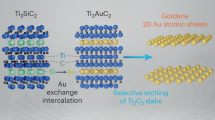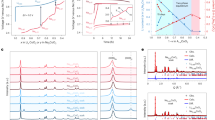Abstract
Nanoporous materials have attracted great technological interest during the past two decades, essentially due to their wide range of applications: they are used as catalysts, molecular sieves, separators and gas sensors as well as for electronic and electrochemical devices1,2,3,4,5. Most syntheses of nanoporous materials reported so far have focused on template-assisted bottom-up processes, including soft templating6,7,8,9,10 (chelating agents, surfactants, block copolymers and so on) and hard templating11,12 (porous alumina, carbon nanotubes and nanoporous materials) methods. Here, we exploit a mechanism implicitly occurring in lithium batteries at deep discharge13,14,15,16,17,18 to develop it into a room-temperature template-free method of wide applicability in the synthesis of not only transition metals but also metal oxides with large surface area and pronounced nanoporosity associated with unprecedented properties. The power of this top-down method is demonstrated by the synthesis of nanoporous Pt and RuO2, both exhibiting superior performance: the Pt prepared shows outstanding properties when used as an electrocatalyst for methanol oxidation, and the RuO2, when used as a supercapacitor electrode material, exhibits a distinctly better performance than that previously reported for non-hydrated RuO2 (refs 1920).
This is a preview of subscription content, access via your institution
Access options
Subscribe to this journal
Receive 12 print issues and online access
$259.00 per year
only $21.58 per issue
Buy this article
- Purchase on Springer Link
- Instant access to full article PDF
Prices may be subject to local taxes which are calculated during checkout




Similar content being viewed by others
References
Davis, M. E. Ordered porous materials for emerging applications. Nature 417, 813–821 (2002).
Corma, A. From microporous to mesoporous molecular sieve materials and their use in catalysis. Chem. Rev. 97, 2373–2419 (1997).
Joo, S. H. et al. Ordered nanoporous arrays of carbon supporting high dispersions of platinum nanoparticles. Nature 412, 169–172 (2001).
Scott, B. J., Wirnsberger, G. & Stucky, G. D. Mesoporous and mesostructured materials for optical applications. Chem. Mater. 10, 3140–3150 (2001).
Bronstein, L. M., Weissenberger, M. C. & Antonietti, M. Mesoporous alumina and aluminosilica with Pd and Pt nanoparticles: structure and catalytic properties. Chem. Mater. 15, 2623–2631 (2003).
Kresge, C. T., Leonowicz, M. E., Roth, W. J., Vartuli, J. C. & Beck, J. S. Ordered mesoporous molecular-sieves synthesised by a liquid-crystal template mechanism. Nature 359, 710–712 (1992).
Yang, P. D., Zhao, D. Y., Margolese, D. I., Chmelka, B. F. & Stucky, G. D. Generalized syntheses of large-pore mesoporous metal oxides with semicrystalline frameworks. Nature 396, 152–155 (1998).
Grosso, D. et al. Periodically ordered nanoscale islands and mesoporous films composed of nanocrystalline multimetallic oxides. Nature Mater. 3, 787–792 (2005).
Deshpande, A. S., Pinna, N., Smarsly, B., Antonietti, M. & Niederberger, M. Controlled assembly of preformed ceria nanocrystals into highly ordered 3D nanostructures. Small 1, 313–316 (2005).
Ba, J. H., Polleux, J., Antonietti, M. & Niederberger, M. Non-aqueous synthesis of tin oxide nanocrystals and their assembly into ordered porous mesostructures. Adv. Mater. 17, 2509–2512 (2005).
Ying, J. Y., Mehnert, C. P. & Wong, M. S. Synthesis and applications of supramolecular-templated mesoporous materials. Angew. Chem. Int. Edn 38, 56–77 (1999).
Wu, Y. Y. et al. Composite mesostructures by nano-confinement. Nature Mater. 3, 816–822 (2004).
Poizot, P., Laruelle, S., Grugeon, S., Dupont, L. & Tarascon, J.-M. Nano-sized transition metal oxides as negative material for lithium-ion batteries. Nature 407, 496–499 (2000).
Poizot, P., Laruelle, S., Grugeon, S. & Tarascon, J.-M. Rationalization of low-potential reactivity of 3d-metal-based inorganic compounds toward Li. J. Electrochem. Soc. 149, A1212–A1217 (2002).
Balaya, P., Li, H., Kienle, L. & Maier, J. Fully reversible homogeneous and heterogeneous Li storage in RuO2 with high capacity. Adv. Funct. Mater. 13, 621–625 (2003).
Badway, F., Cosandey, F., Pereira, N. & Amatucci, G. G. Carbon metal fluoride nanocomposites—High-capacity reversible metal fluoride conversion materials as rechargeable positive electrodes for Li batteries. J. Electrochem. Soc. 150, A1318–A1327 (2003).
Li, H., Balaya, P. & Maier, J. Li-storage via heterogeneous reaction in selected binary metal fluorides and oxides. J. Electrochem. Soc. 151, A1878–A1885 (2004).
Zhang, D. W., Chen, C. H., Zhang, J. & Ren, F. Novel electrochemical milling method to fabricate copper nanoparticles and nanofibers. Chem. Mater. 17, 5242–5245 (2005).
Long, J. W., Swider, K. E., Merzbacher, C. I. & Rolison, D. R. Voltammetric characterization of ruthenium oxide-based aerogels and other RuO2 solids: The nature of capacitance in nanostructured materials. Langmuir 15, 780–785 (1999).
Subramanian, V., Hall, S. C., Smith, P. H. & Rambabu, B. Mesoporous anhydrous RuO2 as a supercapacitor electrode material. Solid State Ion. 175, 511–515 (2004).
Polarz, S., Smarsly, B. & Schattka, J. H. Hierachical porous carbon structures from cellulose acetate fibers. Chem. Mater. 14, 2940–2945 (2002).
Maier, J. Nanoionics: Ion transport and electrochemical storage in confined systems. Nature Mater. 5, 805–815 (2005).
Arico, A. S., Bruce, P. G., Scrosati, B., Tarascon, J.-M. & Schalkwijk, W. V. Nanostructured materials for advanced energy conversion and storage devices. Nature Mater. 4, 366–376 (2005).
Schoonman, J. Nanostructured materials in solid state ionics. Solid State Ion. 135, 5–19 (2000).
Carrette, L., Friedrich, K. A. & Stimming, U. Fuel cells: principles, types, fuels, and applications. ChemPhysChem 1, 162–193 (2000).
Che, G., Lakshmi, B. B., Fisher, E. R. & Martin, C. R. Carbon nanotubule membranes for electrochemical energy storage and production. Nature 393, 346–349 (1998).
Guo, Y.-G. et al. Tin/platinum bimetallic nanotube array and its electrocatalytic activity for methanol oxidation. Adv. Mater. 17, 746–750 (2005).
Ganesan, R. & Lee, J. S. Tungsten carbide microspheres as a noble-metal-economic electrocatalyst for methanol oxidation. Angew. Chem. Int. Edn 44, 6557–6560 (2005).
Pereira, N., Dupont, L., Tarascon, J.-M., Klein, L. C. & Amatucci, G. G. Electrochemistry of Cu3N with lithium—a complex system with parallel processes. J. Electrochem. Soc. 150, A1273–A1280 (2003).
Gillot, F. et al. Electrochemical reactivity and design of NiP2 negative electrodes for secondary Li-ion batteries. Chem. Mater. 17, 6327–6337 (2005).
Acknowledgements
The authors are indebted to the Max Planck Society and acknowledge support in the framework of the ENERCHEM project. The authors thank P. Kopold, A. Schulz and A. Fuchs for their technical support and H. Li and L. Z. Fan for helpful discussions.
Author information
Authors and Affiliations
Corresponding authors
Ethics declarations
Competing interests
The authors declare no competing financial interests.
Supplementary information
Supplementary Information
Supplementary figures S1-S6 (PDF 2104 kb)
Rights and permissions
About this article
Cite this article
Hu, YS., Guo, YG., Sigle, W. et al. Electrochemical lithiation synthesis of nanoporous materials with superior catalytic and capacitive activity. Nature Mater 5, 713–717 (2006). https://doi.org/10.1038/nmat1709
Received:
Accepted:
Published:
Issue Date:
DOI: https://doi.org/10.1038/nmat1709
This article is cited by
-
Progressive growth of the solid–electrolyte interphase towards the Si anode interior causes capacity fading
Nature Nanotechnology (2021)
-
The Electrochemical Tuning of Transition Metal-Based Materials for Electrocatalysis
Electrochemical Energy Reviews (2021)
-
Dealloyed nanoporous materials for rechargeable lithium batteries
Electrochemical Energy Reviews (2020)
-
Nano-assembly and mechanical performance of cold-welded nanoporous Au
Applied Nanoscience (2020)
-
Fabrication of hierarchical core/shell MgCo2O4@MnO2 nanowall arrays on Ni-foam as high–rate electrodes for asymmetric supercapacitors
Scientific Reports (2019)



